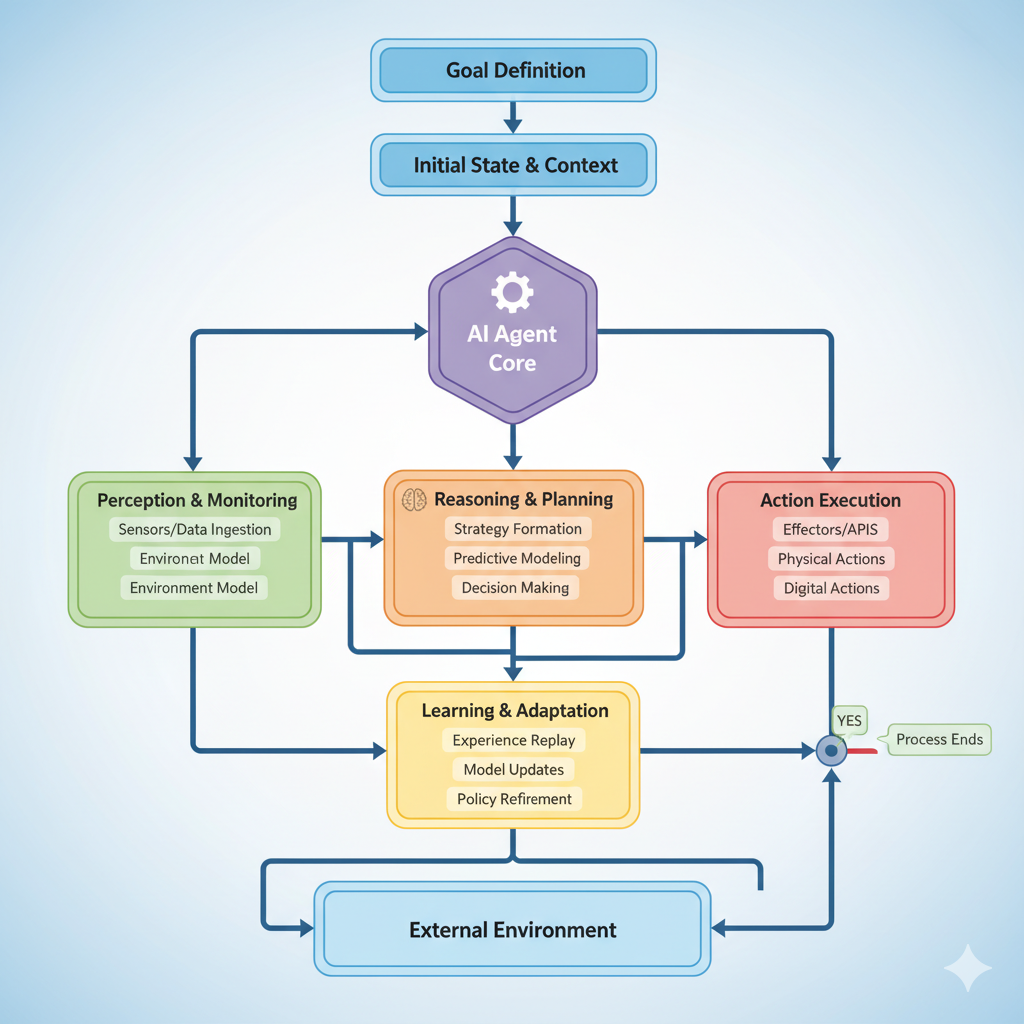Table of Contents
- What is Agentic AI?
- How Does Agentic AI Work?
- Why Agentic AI Matters
- Key Components of Agentic AI
- Applications of Agentic AI
- Beginner’s Steps to Learn Agentic AI
- Intermediate Skills for Mastery
- Advanced Techniques & Best Practices
- Resources & Tools to Accelerate Learning
- Conclusion
What is Agentic AI?
Agentic AI refers to artificial intelligence systems capable of autonomous decision-making and goal-directed behavior. Unlike traditional AI, which follows explicit instructions, agentic AI can:
- Assess situations
- Make independent choices
- Learn from outcomes
- Adapt strategies to achieve goals
Think of it as AI with agency — AI that acts like a self-directed agent rather than just a reactive tool.
Example: A smart AI assistant that schedules your meetings, researches solutions, and negotiates on your behalf without constant human input is operating in an agentic way.
How Does Agentic AI Work?
Agentic AI combines several AI concepts:
- Machine Learning (ML) – Enables AI to learn from data.
- Reinforcement Learning (RL) – Allows AI to make decisions based on rewards and penalties.
- Natural Language Processing (NLP) – Helps AI understand and communicate using human language.
- Planning & Reasoning – Allows AI to set goals, predict outcomes, and optimize decisions.
Workflow:
- Perception: The AI observes its environment.
- Decision-making: It evaluates options and selects the best action.
- Execution: AI acts autonomously.
- Learning: It updates its strategies based on success or failure.
Why Agentic AI Matters
Agentic AI is revolutionary because it:
- Reduces human workload by automating complex tasks
- Improves decision-making through data-driven insights
- Enables AI to handle tasks in dynamic, unpredictable environments
- Unlocks applications in research, healthcare, finance, robotics, and more
Businesses and innovators see agentic AI as a next-generation tool for efficiency, scalability, and innovation.
Key Components of Agentic AI
| Component | Function |
|---|---|
| Autonomy | Makes decisions without human intervention |
| Goal-Directed Behavior | Focuses actions to achieve predefined objectives |
| Learning & Adaptation | Learns from feedback to improve future performance |
| Reasoning & Planning | Evaluates options and predicts outcomes |
| Interaction | Communicates effectively with humans or other AI systems |
Applications of Agentic AI
- Healthcare: AI agents can suggest treatment plans, monitor patients, and optimize hospital operations.
- Finance: Autonomous trading bots make investment decisions based on market patterns.
- Robotics: AI-driven robots perform complex tasks without human oversight.
- Research & Development: Agentic AI accelerates experiments and generates new insights.
- Customer Service: Chatbots with agency handle inquiries, complaints, and problem resolution autonomously.
Beginner’s Steps to Learn Agentic AI
- Understand AI Basics: Learn the fundamentals of machine learning, neural networks, and NLP.
- Explore Reinforcement Learning (RL): Study how AI learns from trial and error.
- Learn Python & AI Libraries: Python, TensorFlow, PyTorch, and OpenAI API are essential.
- Experiment with Simple Agents: Start with environments like OpenAI Gym to create AI agents.
- Study Decision-Making & Planning: Learn algorithms like A*, Dijkstra, and Monte Carlo Tree Search.
Intermediate Skills for Mastery
- Multi-Agent Systems: Learn how multiple AI agents interact and collaborate.
- Autonomous Systems Design: Understand sensors, environment modeling, and simulation.
- Ethics & Safety in AI: Explore responsible AI practices and risk mitigation.
- Advanced Reinforcement Learning: Deep RL, Policy Gradients, Actor-Critic methods.
Advanced Techniques & Best Practices
- Hierarchical Agentic AI: Divide tasks into sub-agents for complex problem solving.
- Self-Supervised Learning: AI learns patterns without labeled data.
- Human-AI Collaboration: Balance autonomy with human oversight for optimal outcomes.
- Continuous Learning Systems: Enable AI to adapt indefinitely to changing environments.
Resources & Tools to Accelerate Learning
- Books: Artificial Intelligence: A Modern Approach, Reinforcement Learning: An Introduction
- Courses: Coursera, Udemy, DeepLearning.AI
- Libraries & Frameworks: TensorFlow, PyTorch, OpenAI Gym, RLlib
- Communities: AI research forums, Reddit r/MachineLearning, GitHub repositories
Conclusion
Agentic AI is transforming the way we interact with technology, moving from simple automation to intelligent, autonomous decision-making. From beginner to mastery, understanding its fundamentals, practicing with real-world projects, and leveraging modern AI tools can position you at the forefront of this revolutionary technology.
